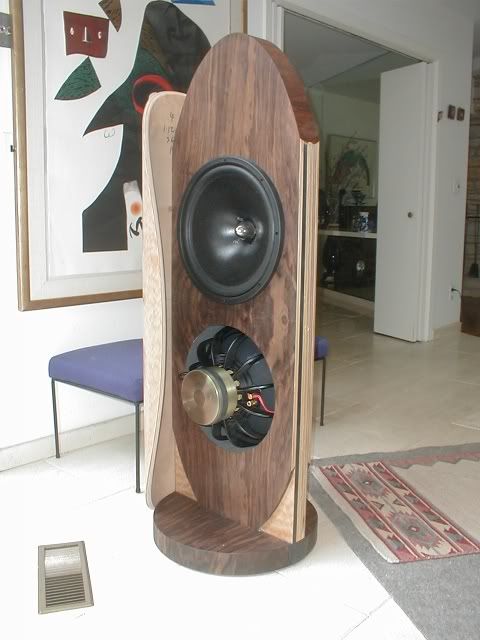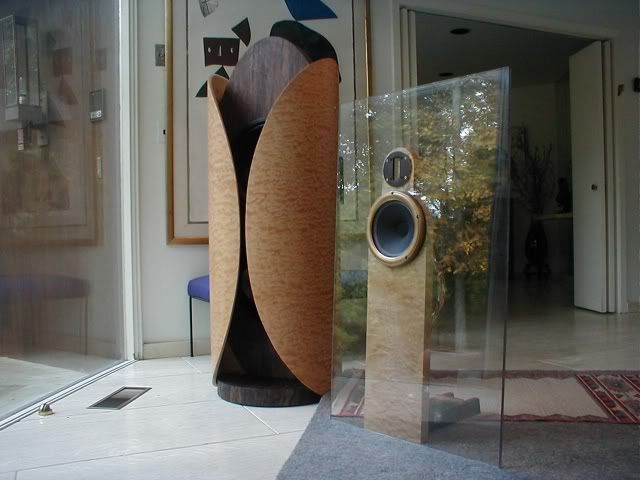The weakest link of my audio system today is bass reproduction. It has very positive aspects, as sounding tight and clean. BUT.....
It is directional, and is not well integrated. It sounds actually disconnected from the main horn towers. Beside this, while my main towers do emanate sound from 1,7m height vertically to the floor, which i very much like, the bass horn is only 1,1m high, and emanates sound only from this vertical size. I would like to emanate at least bass from the same high level, down, as the main horn towers.
There are different methods. the easyest for me would be to build a second, identical bass horn, and place it above the first bass horn. But i am thinking if i might find other configurations, which eventually will work better. Direct radiator and bass reflex line array , open baffle, TH, etc. i would like to know ideas, which could result in my next improvement of my system in the bass region. What eventually could work best ? Any suggestion ?
Angelo
It is directional, and is not well integrated. It sounds actually disconnected from the main horn towers. Beside this, while my main towers do emanate sound from 1,7m height vertically to the floor, which i very much like, the bass horn is only 1,1m high, and emanates sound only from this vertical size. I would like to emanate at least bass from the same high level, down, as the main horn towers.
There are different methods. the easyest for me would be to build a second, identical bass horn, and place it above the first bass horn. But i am thinking if i might find other configurations, which eventually will work better. Direct radiator and bass reflex line array , open baffle, TH, etc. i would like to know ideas, which could result in my next improvement of my system in the bass region. What eventually could work best ? Any suggestion ?
Angelo
If you are finding the bass directional, could it be that the horn woofers are crossed too high?
they are crossed at 150hz
For many years, I crossed over at 140 Hz 24dB/8ave to a single corner horn. Despite what others say, I assure you there was no sense what so ever of the woofer location on any content I can recall. Moreover, the woofer location was often meters from the rest of the system and easily detected if there were directional effects.
I now cross-over around 110 Hz. Not because of directional effects but because I finally have enough horsepower to drive my Dayton-Wright ESLs lower.
Having a mixed-bass sub is a good idea too. And esp. when you have two or more subs in diversity installation to address room influences.
Ben
I now cross-over around 110 Hz. Not because of directional effects but because I finally have enough horsepower to drive my Dayton-Wright ESLs lower.
Having a mixed-bass sub is a good idea too. And esp. when you have two or more subs in diversity installation to address room influences.
Ben
they are crossed at 150hz
What's the slope? 150 Hz is high-ish if the slope is not steep; possibly OK if it's 24 db/octave (although I would go a bit lower than 150 Hz/24dB myself).
What's the slope? 150 Hz is high-ish if the slope is not steep; possibly OK if it's 24 db/octave (although I would go a bit lower than 150 Hz/24dB myself).
my active crossover has 24db slope. I am looking to try out maibe something different, than i was accostumed to hear until now. For example a dipole line array with H frame, or something as proposed recently by Nelson Pass.....i guess it was ripole, or so....
Bad time alignment can also cause a directional cue and disconnected sense.
I can promise you that my system had terrible time alignment yet no directional cues or disconnected sense what so ever. While that's nothing but my admittedly biased perception, I think over dozens of years I or visitors just might have noticed (including times when I was inclined to puzzle my visitors).
It is a common error to note a perturbation of sound which is profoundly evident in theory and on charts and wave traces and think it must be audible. I'd put a large part of talk about hearing phase in that category.
Haas Effect is strong.
BTW, I agree that anything less sharp than 140 Hz and 24dB/8ave likely would be audible, as the math clearly suggests.
On the other hand, my brain does not seem too good at localizing a pure 140 Hz tone in my room, with no help from the Haas Effect, whatever the textbooks say.
Ben
Last edited:
I can promise you that my system had terrible time alignment yet no directional cues or disconnected sense what so ever. While that's nothing but my admittedly biased perception, I think over dozens of years I or visitors just might have noticed (including times when I was inclined to puzzle my visitors).
It is a common error to note a perturbation of sound which is profoundly evident in theory and on charts and wave traces and think it must be audible. I'd put a large part of talk about hearing phase in that category.
Haas Effect is strong.
BTW, I agree that anything less sharp than 140 Hz and 24dB/8ave likely would be audible, as the math clearly suggests.
On the other hand, my brain does not seem too good at localizing a pure 140 Hz tone in my room, with no help from the Haas Effect, whatever the textbooks say.
Ben
It definitely depends on the listener and position of the misaligned component. ie. a mono subwoofer that is 7ms+ behind the mains if placed between them will not be as detectible as one placed off to one side (say 4ft to the left of the left main in a home listening room) which can draw the stereo image to it. Although I may be an exception after 25years of setting up big rigs I'm definitely sensitive to misalignments greater than 5ms above 60hz where the 1st harmonic is on the other side of the crossover.
I assure I included no tweaks to make it work. But I can't assure you my ears are any good - but I hope you'll take that on faith.
I remind you that Toole's book (and the present discussion) is about "psycho-acoustics" not "acoustics."
Ben
I remind you that Toole's book (and the present discussion) is about "psycho-acoustics" not "acoustics."
Ben
Psychoacoustics is essentially statistics, and in my book it's perfectly alright for any two people to be at opposite ends of any given Gaussian distribution. For example it is well known that some aspects of frequency response and stereo perceptions vary with pinna shapes, which will lead to apparent divergence of opinion whereas it actually is an anatomically unavoidable divergence of sensory input.whatever the textbooks say
Which may also be a sign of very low harmonic distortion from your system: most people actually localize "pure" bass by its not-so-pure harmonics. Getting well and truly rid of them has been the main concern in studying psychoacoustics of LF localization, and it has only been achieved fairly recently, IIRC.my brain does not seem too good at localizing a pure 140 Hz tone in my room
SOCIAL AUDIO DISTORTION FORUM :: View topic - Ribbon Tweeter + PHL Audio + Lambda loudspeaker designs


I love this Karlsson style open baffle design. Anyone has a idea about the advantage of such a configuration, and difference , soundwise, compared to normal boxed woofers ?


I love this Karlsson style open baffle design. Anyone has a idea about the advantage of such a configuration, and difference , soundwise, compared to normal boxed woofers ?
Last edited:
- Status
- Not open for further replies.
- Home
- Loudspeakers
- Subwoofers
- How to get the best bass reproduction ?